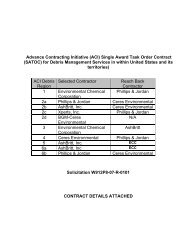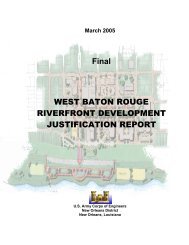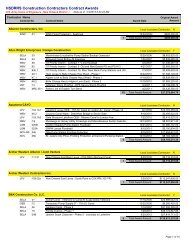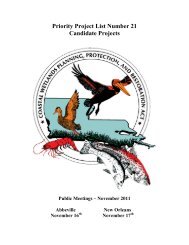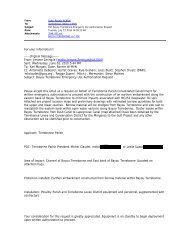LCA Myrtle Grove - US Army Corps of Engineers New Orleans District
LCA Myrtle Grove - US Army Corps of Engineers New Orleans District
LCA Myrtle Grove - US Army Corps of Engineers New Orleans District
You also want an ePaper? Increase the reach of your titles
YUMPU automatically turns print PDFs into web optimized ePapers that Google loves.
9. MODEL CERTIFICATION AND APPROVAL<br />
EC 1105-2-407 mandates the use <strong>of</strong> certified or approved models for all planning activities to ensure the<br />
models are technically and theoretically sound, compliant with <strong>US</strong>ACE policy, computationally accurate,<br />
and based on reasonable assumptions. Planning models, for the purposes <strong>of</strong> the EC, are defined as any<br />
models and analytical tools that planners use to define water resources management problems and<br />
opportunities, to formulate potential alternatives to address the problems and take advantage <strong>of</strong> the<br />
opportunities, to evaluate potential effects <strong>of</strong> alternatives and to support decision making. The use <strong>of</strong> a<br />
certified/approved planning model does not constitute technical review <strong>of</strong> the planning product. The<br />
selection and application <strong>of</strong> the model and the input and output data is still the responsibility <strong>of</strong> the<br />
users and is subject to DQC, ATR, and IEPR (if required).<br />
EC 1105-2-407 does not cover engineering models used in planning. The responsible use <strong>of</strong> well-known<br />
and proven <strong>US</strong>ACE developed and commercial engineering s<strong>of</strong>tware will continue and the pr<strong>of</strong>essional<br />
practice <strong>of</strong> documenting the application <strong>of</strong> the s<strong>of</strong>tware and modeling results will be followed. As part<br />
<strong>of</strong> the <strong>US</strong>ACE Scientific and Engineering Technology (SET) Initiative, many engineering models have been<br />
identified as preferred or acceptable for use on <strong>Corps</strong> studies and these models should be used<br />
whenever appropriate. The selection and application <strong>of</strong> the model and the input and output data is still<br />
the responsibility <strong>of</strong> the users and is subject to DQC, ATR, and IEPR (if required).<br />
Planning Models. The following planning models are anticipated to be used in the development <strong>of</strong> the<br />
decision document:<br />
A. General. Most <strong>of</strong> the models to be employed in the study have either been developed by or for the<br />
<strong>US</strong>ACE.<br />
Ecosystem Output Model –<br />
The Wetland Value Assessment (WVA) methodology is a quantitative habitat-based assessment<br />
methodology developed for use in determining wetland benefits <strong>of</strong> project proposals submitted<br />
for funding under the Coastal Wetlands Planning, Protection, and Restoration Act (CWPPRA).<br />
The WVA quantifies changes in fish and wildlife habitat quality and quantity that are expected to<br />
result from a proposed wetland restoration project. The results <strong>of</strong> the WVA, measured in<br />
Average Annual Habitat Units (AAHUs), can be combined with cost data to provide a measure <strong>of</strong><br />
the effectiveness <strong>of</strong> a proposed project in terms <strong>of</strong> annualized cost per AAHU gained. In<br />
addition, the WVA methodology provides an estimate <strong>of</strong> the number <strong>of</strong> acres benefited or<br />
enhanced by the project and the net acres <strong>of</strong> habitat protected/restored.<br />
The WVA has been developed strictly for use in determining the wetland benefits <strong>of</strong> proposed<br />
CWPPRA projects; it is not intended to provide a detailed, comprehensive methodology for<br />
establishing baseline conditions within a project area. Some aspects <strong>of</strong> the WVA have been<br />
defined by policy and/or functional considerations <strong>of</strong> the CWPPRA; therefore, user-specific<br />
modifications may be necessary if the WVA is used for other purposes.<br />
The WVA is a modification <strong>of</strong> the Habitat Evaluation Procedures (HEP) developed by the U.S.<br />
Fish and Wildlife Service (U.S. Fish and Wildlife Service 1980). HEP is widely used by the Fish and<br />
Wildlife Service and other Federal and State agencies in evaluating the impacts <strong>of</strong> development<br />
projects on fish and wildlife resources. A notable difference exists between the two<br />
12



